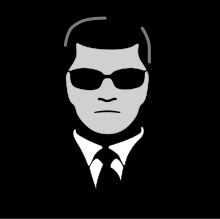Men in black
In popular culture and UFO conspiracy theories, men in black (MIB) are supposed men dressed in black suits who claim to be quasi-government agents who harass, threaten or assassinate UFO witnesses to keep them quiet about what they have seen. It is sometimes implied that they may be aliens themselves. The term is also frequently used to describe mysterious men working for unknown organizations, as well as various branches of government allegedly designed to protect secrets or perform other strange activities. The term is generic, used for any unusual, threatening or strangely behaved individual whose appearance on the scene can be linked in some fashion with a UFO sighting.[1] Several alleged encounters with the men in black have been reported by UFO researchers and enthusiasts.
Stories about allegedly real-life men in black inspired the semi-comic science fiction Men in Black franchise of comic books, films and other media.
Folklore[edit]
Folklorist James R. Lewis compares accounts of men in black with tales of people encountering Lucifer and speculates that they can be considered a kind of "psychological drama."[2]
Ufologists[edit]
Men in black figure prominently in ufology and UFO folklore. In the 1950s and 1960s, UFOlogists adopted a conspiratorial mindset and began to fear they would be subject to organized intimidation in retaliation for discovering "the truth of the UFOs."[3]
In 1947, Harold Dahl claimed to have been warned not to talk about his alleged UFO sighting on Maury Island by a man in a dark suit. In the mid-1950s, the ufologist Albert K. Bender claimed he was visited by men in dark suits who threatened and warned him not to continue investigating UFOs. Bender maintained that the men in black were secret government agents who had been given the task of suppressing evidence of UFOs. The ufologist John Keel claimed to have had encounters with men in black and referred to them as "demonic supernaturals" with "dark skin and/or 'exotic' facial features." According to the ufologist Jerome Clark, reports of men in black represent "experiences" that "don't seem to have occurred in the world of consensus reality."[4]
Historian Aaron Gulyas wrote, "during the 1970s, 1980s, and 1990s, UFO conspiracy theorists would incorporate the Men in Black into their increasingly complex and paranoid visions."[3]
In his article, "Gray Barker: My Friend, the Myth-Maker," John C. Sherwood claims that, in the late 1960s, at the age of 18, he cooperated when Gray Barker urged him to develop a hoax—which Barker subsequently published—about what Barker called "blackmen," three mysterious UFO inhabitants who silenced Sherwood's pseudonymous identity, "Dr. Richard H. Pratt."[5]
In popular culture[edit]
The G-Man from the Half-Life video game franchise is said to have characteristics of the men in black, including an awkward grasp of human speech and mannerisms.
See also[edit]
Notes[edit]
- ^ Clark, Jerome (1996). The UFO Encyclopedia, volume 3: High Strangeness, UFO's from 1960 through 1979. Omnigraphis. 317–18.
- ^ James R. Lewis (9 March 1995). The Gods Have Landed: New Religions from Other Worlds. SUNY Press. pp. 218–. ISBN 978-0-7914-2330-1. Archived from the original on 2 July 2014. Retrieved 16 March 2016.
- ^ a b Aaron John Gulyas (25 January 2016). Conspiracy Theories: The Roots, Themes and Propagation of Paranoid Political and Cultural Narratives. McFarland. pp. 86–. ISBN 978-1-4766-2349-8.
- ^ Harris, Aisha. "Do UFO Hunters Still Report "Men in Black" Sightings?". Slate. Slate.com. Archived from the original on 14 July 2014. Retrieved 3 July 2014.
- ^ Sherwood, John C. "Gray Barker: My Friend, the Myth-Maker". Skeptical Inquirer. Archived from the original on 2011-05-12. Retrieved 2006-10-10.
References[edit]
- Clark, Jerome (1996). The UFO Encyclopedia, volume 3: High Strangeness, UFO's from 1960 through 1979. Omnigraphis. ISBN 1-55888-742-3.
- Condon, Edward (1968). Gilmor, Daniel S. (ed.). Final Report of the Scientific Study of Unidentified Flying Objects. New York City: Batnam. ISBN 0-552-04747-3. ISBN.
- Wallace, Chevon. "Albert Bender and the M.I.B. Mystery". Bridgeport Public Schools. Archived from the original on 2011-07-19. Retrieved 2006-09-10.
Further reading[edit]
- The Mothman Prophecies - 1975 book by John Keel an account of alleged sightings of a large, winged creature called Mothman in the vicinity of Point Pleasant, West Virginia, during 1966 and 1967, it also narrates encounters of the author with "Men In Black"
- Los Hombres De Negro y los OVNI - 1979 book by Uruguayan ufologist Fabio Zerpa
